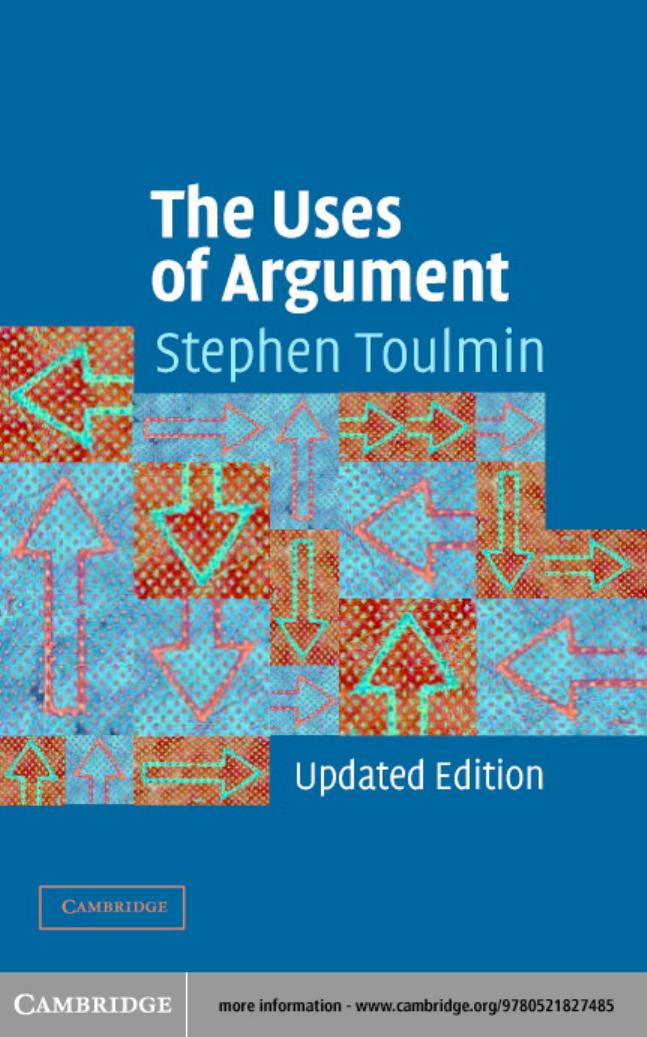The Uses of Argument by Stephen E. Toulmin

Author:Stephen E. Toulmin [Toulmin, Stephen E.]
Language: eng
Format: azw3, pdf
Publisher: Cambridge University Press
Published: 2003-07-06T16:00:00+00:00
Some Crucial Distinctions
One major task remains for us to perform in this essay: we have to distinguish the division of arguments into analytic and substantial from three or four other possible modes of division. The dangers resulting from confusing these distinctions, and still more from running them together, are serious and can be avoided only with care.
To begin with, the division into analytic and substantial arguments does not correspond at all exactly to the division into formally valid arguments and others. An argument in an field whatever may be expressed in a formally valid manner, provided that the warrant is formulated explicitly as a warrant and authorises precisely the sort of inference in question: this explains how mathematical computations can be formally valid, even when the data argued from are entirely past and present observations and the conclusion argued to is a prediction about the future. On the other hand, an argument may be analytic, and yet not be expressed in a formally valid way: this is the case, for instance, when an analytic argument is written out with the backing of the warrant cited in place of the warrant itself.
Nor does the distinction between analytic and substantial arguments correspond, either, to that between warrant-using and warrant-establishing arguments. In a very few cases, warrant-establishing arguments can be stated in a form which is formally valid: thus the argument, âJack has three sisters; the first has red hair, the second has red hair, the third has red hair; so all Jackâs sisters have red hairâ, might be said to be at once warrant-establishing, formally valid and analytic. But, by and large, these characteristics vary independently. There can be warrant-using and warrant-establishing arguments both in the analytic field, and in other, substantial fields of argument, and one cannot seriously hope to make the two distinctions cut along one and the same line.
Again, it has sometimes been thought that one could mark off a specially âlogicalâ class of arguments by reference to the sorts of words appearing in them. In some arguments, for instance, the words âallâ and âsomeâ play a crucial part, and such arguments as these deserve separate consideration. But if we do mark them off from others, we must immediately observe that the division which results corresponds no more closely than the previous two to the division between analytic arguments and substantial ones. Not all arguments are analytic in which the word âallâ appears in the major premiss or warrant: this will be so only in cases where the process of establishing the warrant would involve ipso facto checking the truth of the conclusion now to be inferred with its aid, and we do not restrict our use of âallâ to such cases. The task of identifying analytic arguments cannot therefore be performed by looking for key words like âallâ and âsomeâ: it can be done only by looking at the nature of the problem under investigation, and the manner in which we establish the warrants relevant to its solution.
These three distinctions can be recognised easily enough.
Download
This site does not store any files on its server. We only index and link to content provided by other sites. Please contact the content providers to delete copyright contents if any and email us, we'll remove relevant links or contents immediately.
Cecilia; Or, Memoirs of an Heiress — Volume 1 by Fanny Burney(32434)
Cecilia; Or, Memoirs of an Heiress — Volume 2 by Fanny Burney(31871)
Cecilia; Or, Memoirs of an Heiress — Volume 3 by Fanny Burney(31854)
The Lost Art of Listening by Michael P. Nichols(7406)
Asking the Right Questions: A Guide to Critical Thinking by M. Neil Browne & Stuart M. Keeley(5635)
We Need to Talk by Celeste Headlee(5542)
On Writing A Memoir of the Craft by Stephen King(4863)
Dialogue by Robert McKee(4321)
Pre-Suasion: A Revolutionary Way to Influence and Persuade by Robert Cialdini(4150)
I Have Something to Say: Mastering the Art of Public Speaking in an Age of Disconnection by John Bowe(3840)
Elements of Style 2017 by Richard De A'Morelli(3307)
The Book of Human Emotions by Tiffany Watt Smith(3238)
Fluent Forever: How to Learn Any Language Fast and Never Forget It by Gabriel Wyner(3028)
Name Book, The: Over 10,000 Names--Their Meanings, Origins, and Spiritual Significance by Astoria Dorothy(2939)
Good Humor, Bad Taste: A Sociology of the Joke by Kuipers Giselinde(2903)
Why I Write by George Orwell(2874)
The Art Of Deception by Kevin Mitnick(2736)
The Grammaring Guide to English Grammar with Exercises by Péter Simon(2710)
Ancient Worlds by Michael Scott(2625)
